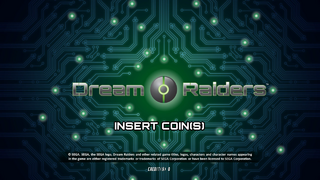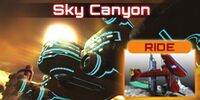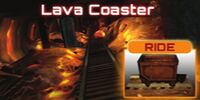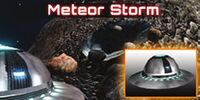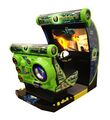Dream Raiders
From Sega Retro
| Dream Raiders | |||||||||||||
|---|---|---|---|---|---|---|---|---|---|---|---|---|---|
| System(s): Sega RingWide | |||||||||||||
| Publisher: Sega Amusements USA | |||||||||||||
| Developer: Sega Amusements Europe, Gamewax | |||||||||||||
| Genre: Shoot-'em-Up, Simulation | |||||||||||||
| Number of players: 1-2 | |||||||||||||
|
This teeny-tiny article needs some work. You can help us by expanding it.
Dream Raiders is a motion simulator shooting game developed by Gamewax and Sega Amusements Europe for Sega RingWide arcade hardware in 2012. It was designed to bridge the gap between 4-D motion “rides” and interactive video games.
The cabinet, dubbed the "Dream Machine", features a large, two-person seat that tilts and moves with the on-screen action, while built-in fans provide the sensation of wind to players. The only controls are the "Dream Blasters", glowing light guns affixed to the cabinet in the style of similar Sega games such as Let's Go Island: Lost on the Island of Tropics.
Contents
Gameplay
Dream Raiders is a simple on-rails shooting game, similar to the earlier Sega arcade title, Rail Chase. Up to two players work cooperatively, using their "Dream Blasters" to shoot obstacles and enemies encountered in the "Dream Worlds", as well as collect crystals. Upon inserting the required credits, the players are taken to a level select screen in a futuristic laboratory by a cybernetic host, where one of six Dream Worlds may be chosen for gameplay. If this level is completed, one of three additional bonus stages may be chosen. After the bonus stage is completed, the game ends. Because the game was designed as a casual "experience", the levels are quite easy to complete.
As the player travels through the Dream World, enemies and other items will fly towards them. The game highlights these objects with a red crosshair marker, making it very easy for the players to aim at them with their Dream Blasters. If a non-collectible object is not shot down by a player, it will "hit" them and decrease their life gauge. Every enemy and item hit by the player will score points. At the end of the stage, points are added to the player's score based on the amount of life gauge left at the end of the game.
When an enemy is hit with a full life gauge, the score is multiplied by a factor of 10. If the player has 50% or more life gauge, the score is multiplied by 5. The level ends when the boss at the end of the stage has been defeated, or if all player life gauges have been completely depleted. One or two players may play the game at once. A second player may join at any time during gameplay (with the exception of the bonus stages, which prohibit new player entry after the first 40 seconds of play). Two players may have their own seperate halves of the screen for their "hit zones", individual life meters, and individual scores, or they may share them, depending on how the operator configures the game's settings.
Levels
Dream Raiders contains nine "Dream Worlds" for the player to select from at the start of the game. Each level runs about 3 minutes long and features a simulated "ride" through different environments. Players must blast through obstacles and enemies en route to the boss at the end of each course, collecting crystals along the way for bonus points.
Tier 1 Levels
These six levels are available to choose from at the start of the game.
Bonus Stages
One of these levels can only be accessed if the first-tier level's boss has been defeated.
History
Development
Dream Raiders was designed almost entirely by Sega Amusements Europe, with software design by Gamewax and technical support from Sega Japan's R&D teams. Sega had been interested in creating a product to bridge the divide between “passive” simulator rides and video games. Their goal was to create a cost-effective “ride” suitable for all ages, with a casual shooting element that encouraged inexperienced players, gave them an immersive experience, and ultimately delivered a sense of achievement. The developers wanted to have a wide range of motion experiences and felt that a dream motif was a great way to encompass such a variety of level designs. The cabinet was designed with this theme in mind, and was dubbed a “Dream Machine” that transported its occupants into these adventures.
Early in development, Dream Raiders had a complex back story, but this was eventually removed because Sega felt that cutscenes and other narratives slowed down the "momentum" of the game. With these elements removed, the game became a casual experience that allows the player to make their own interpretation of the events. Before its' release, Dream Raiders underwent a more extensive marketing campaign than other Sega arcade titles, with “SpyCam” sneak peeks, teaser footage on YouTube, and a dedicated Facebook page to reach out to fans. This was part of a new initiative by Sega Amusements to get players involved with their arcade titles as early as possible.
The cabinet development process was very detailed and involved a lot of prototyping. Quite early on in this process it was realized that in order for the game to move properly, the guns would be need to be attached to the seat and move with the players rather than be fixed to the monitor cabinet. In developing the seat itself, there was much experimentation with the positioning of the players center of gravity and how that affected their sensation of motion. The developers discovered that by simply allowing the players feet to hang off the seat naturally greatly enhanced the feeling of movement. Fans to mimic the feeling of acceleration were originally placed above the monitor, but due to the seat's motion, the airflow was unable to be directed towards the player. As a result, an axial flow fan was placed in the control panel area in the final model. The game runs in 720p HD with a 55" screen. The developers had wished to create a true 1080p title with a higher-end system, but economic conditions forced them to settle with the less-powerful, but more cost-effective, RingWide platform.
